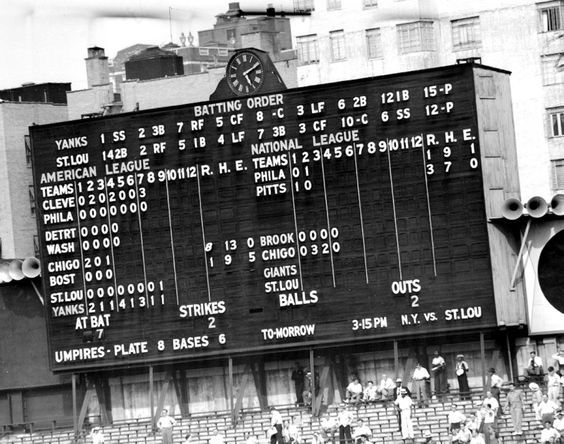 That's the Yankee Stadium scoreboard from July 26, 1939 with the game score at bottom left. You'll notice the Yankees have scored in every inning in their contest against the St Louis Browns, and ended up winning 14-1. Despite all the runs the game took just under two hours to play, helped along by the pitchers collectively issuing only four walks and striking out a scant three batters.
That's the Yankee Stadium scoreboard from July 26, 1939 with the game score at bottom left. You'll notice the Yankees have scored in every inning in their contest against the St Louis Browns, and ended up winning 14-1. Despite all the runs the game took just under two hours to play, helped along by the pitchers collectively issuing only four walks and striking out a scant three batters.The scoreboard shows the situation in the top of the 9th with two outs and two strikes on Browns third baseman Harlond Clift who flied to center to end the game. And notice that there are only two umpires, not four as there would be today, on the field.
If there were ever the perfect circumstances for a team to score in every inning it was that day and those teams. The 1939 New York Yankees won 106 games, losing only 45, going on to sweep the Cincinnati Reds in the World Series, while the pathetic Browns went 43-111, finishing in last place. The Yankees entered the day at 63-25, while St Louis held a 24-63 record. Starting pitcher for the Gothamites was future Hall of Famer Red Ruffing with a 13-3 record and ERA of 2.60, while George Gill took the mound for the Browns, sporting a 1-8 mark with an ERA of 6.78. The Yankees would win 19 of 22 contests with the Browns in 1939 having already won 13 of 14. For the season, the New York squad had by far the best offense in the league, averaging 6.36 runs per games, while the Brownie pitchers were battered for 6.01 runs on average, the worst figure in the AL.
At the plate, two more future Hall of Famers led the Yankee assault; catcher Bill Dickey went 4-5 with three home runs, while center fielder Joe DiMaggio added three hits including two doubles, ending the day batting .408.
The Yankee lineup was so strong it survived the retirement of Lou Gehrig eight games into the season due to the onset of the disease that would take the life of The Iron Horse two years later. The Yankees lost Gehrig's last game leaving them tied for first with a 5-3 record and then proceeded to rip off 28 wins in the next 32 contests. The rest of the season was pretty clear sailing except when facing the Boston Red Sox, against whom they only won 8 of 19 games, including the shocking loss of all five games in a series played at Yankee Stadium in early July. The only other trouble they encountered was against the best pitcher in the AL, Bob Feller of the Cleveland Indians, who beat them three times in three starts. When playing anyone other than the Red Sox or Feller, the Yanks compiled a ridiculous 98-31 record.
In contrast, the Browns were 4-4 after eight games, only a game behind the Yankees, but losing 31 of their next 40 left them in their usual position of last place.
Reviewing the season in detail I was struck by the details on attendance. The Yankees were also first in attendance with 859,785 or about 11,200 per game. However, the difference between attendance on weekends and holidays versus weekdays was much bigger than we see today primarily because there were no night games. The July 26 contest was on a Wednesday and attracted only 4,843 spectators and the highest attendance for any weekday game during the entire season was only 12,400. By far the two biggest crowds were the 61,808 who showed up on July 4 to honor Lou Gehrig and the August 6 doubleheader against the Cleveland Indians when 76,753 packed the stands and watched Bob Feller and Mel Harder beat the home town team.
St Louis was last in attendance with only 109,159 for the season or about 1,420 a game. The low point may have been a three game home series in July against the Washington Senators with attendance of 728, 621, and 867. Though the last series of the year, a doubleheader against the Chicago White Sox on Sept, 30 with a mere 433 attendees, followed by the season closer the next day with 707 in the stands may have been worse. The 15,328 fans who paid to watch the Detroit Tigers sweep a doubleheader against the Browns on Sunday, May 14 was the biggest crowd of the season. St Louis fans became more discouraged as the season progressed with the largest turn out during the final two months on Sunday, August 20 when 4,514 sat in the stands for a game against the Tigers.
No comments:
Post a Comment